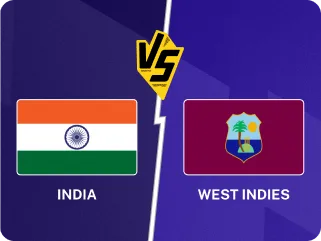
The Axar Patel promotion
After losing two early wickets, India made the bold move of sending out Axar Patel at No.4. On a typically spicy New York wicket that was helping the Pakistan seamers generate significant movement, India decided shielding their best T20 batter in Suryakumar Yadav from the new ball was the way to go.
Promoting Axar is not a new idea, but this time it came with an added risk. He is renowned as a capable player of spin, but struggles more against pace, and it was the quicks who were causing India trouble. Still, the move paid off, at least partly, as Axar's 18-ball 20 took the new ball out of the equation by the time SKY arrived to the crease. That he wasn't able to make an impact still, was a separate matter.
Iftikhar gets a bowl, Shadab doesn't
With two left-handers in Rishabh Pant and Axar Patel at the crease, Babar Azam turned to off-spinner Iftikhar Ahmed for the seventh over. With seamers getting enough help from the conditions until then, it was a move that could have backfired, but as it turned out, the Nassau County Stadium surface was equally helpful for spinners as they got grip and purchase. Iftikhar managed to slip in a seven-run over. The seventh over is, on average, the second slowest over in a T20 innings, after the first over, and Babar bought himself some flexibility later on.
With at least one left-hander batting from the second over till the very end, Pakistan didn't give the ball to leg-spinner Shadab Khan, while left-arm spinner Imad Wasim bowled three overs for just 17.
India's middle order struggles to adapt
India went from 89-3 to 96-7 in the space of three overs, eventually finishing on 119. Pakistan nailed their plans, but were significantly helped by the Indian middle order.
On a pitch with spongy bounce and the ball occasionally stopping on the surface, several Indian batters got out to on-the-rise aerial shots down the ground. SKY hit a full-ish Haris Rauf delivery straight to mid-off, and Rishabh Pant skied one to mid-off as well as he charged down the track against Amir.
Shivam Dube and Ravindra Jadeja both were guilty of making aimless pushes, lobbing catches to the bowler and short cover respectively. Hardik Pandya then got out attempting to pick up a length ball on leg stump towards the longer boundary against the breeze, another low percentage option. A total around 120 always looked like it would be competitive, and so it proved - just. India didn't need to aim as high as they did, and almost paid the price.
Pandya's strange tactics with the tail
When Jadeja was dismissed in the 15th over, Pandya was left with only Arshdeep Singh, Jasprit Bumrah, and Mohammed Siraj for company. Expected to hog most of the strike, Pandya strangely let Arshdeep face 13 of the 20 deliveries that the two batted together.
He didn't make an attempt to play the last ball of the 15th over, took a single off the third ball of the 16th, then allowed Arshdeep to take a single off the last ball of the 16th to retain strike for the 17th, turning down a sharp double at this point. In fact, Pandya did not face a single ball in the 17th over. A bit more game awareness, and India could have had a few more runs to play with.
Smart usage of Bumrah
With a low total to defend, India needed to optimise their usage of Bumrah and hope that he delivered key wickets. They did the former and he did the latter.
Bumrah was not given the new ball, quite like the first game against Ireland. This time, however, he came into the attack quicker, in the third over, unlike the previous game where he started his spell only in the sixth over. He created a chance in his first over, getting Rizwan to hit one down the throat of fine leg, where Shivam Dube made a meal of the catch. After conceding four in his first over, Bumrah returned for his second inside the powerplay and got rid of Babar Azam, getting him to edge to first slip.
As the game looked like it was slipping away from India's grasp through the middle overs, the temptation to bowl Bumrah in the desperate search of a wicket was real. But Rohit Sharma timed his re-entry to near perfection. With 36 needed off the last six overs, Bumrah came back for the 15th over and rattled Rizwan's stumps with his first delivery, conceding just three in that over. As other bowlers rallied around him, there was another decision to make after the 17th.
Each of the three front-line seamers had an over left. Pakistan needed 30 with five wickets in hand. Giving Bumrah the ball would have made sense, in an attempt to make it as tough as possible for Pakistan in the last two overs. But Rohit held him back for 19th, where he conceded just three runs and took the wicket of Iftikhar Ahmed to hand Arshdeep Singh the game on a platter with 18 to defend in the final over.
India have registered a memorable heist over Pakistan👏
— Wisden (@WisdenCricket) June 9, 2024
Relive the match here: https://t.co/0OwGVi2ebE pic.twitter.com/BuSxipkAiv
How slow is too slow for Rizwan?
Rizwan tried to attack on occasions through the innings, but the attacking shots were sandwiched between extended periods of lull. At the end of the powerplay, he was batting on 17 off 23. After the powerplay, he added only 14 off 21 balls. The target wasn't huge and it made sense for one of the top order batters to look to anchor the chase through, but perhaps Rizwan miscalculated and left too much for too late. At a strike rate of 70.5, it was the third-slowest 30-plus score by a Full Member batter in a men's T20I, and Babar bemoaned the number of middle-overs dot balls after the game.
Axar winning a negative matchup against Imad at a crunch time
India needed to get four overs out of Jadeja and Axar Patel. Jadeja bowled the eighth and tenth for just 10 runs, but he had the luxury of bowling to two right handers. Axar, on the other hand, bowled the 11th and the 16th, out of which four balls in each were bowled to left-handers.
The 16th over was especially tricky. Pakistan needed 37 off the last five, with Imad and Shadab at the crease. After a single off the second ball, Imad came on strike on the third ball. With four overs of pace to come, Imad and Pakistan needed to get as many as they could have off the four balls of Axar's over.
The left-arm spinner, however, was at his defensive best, bowling short of length darts outside Wasim's off stump from round the wicket. It gave him no opportunity to swing across the line to the leg side, and the subtle changes in release point and speed ensured that Imad missed three cut shots before finally connecting the fourth for a single. Pakistan had just lost the golden window to make the decisive move in the game.








